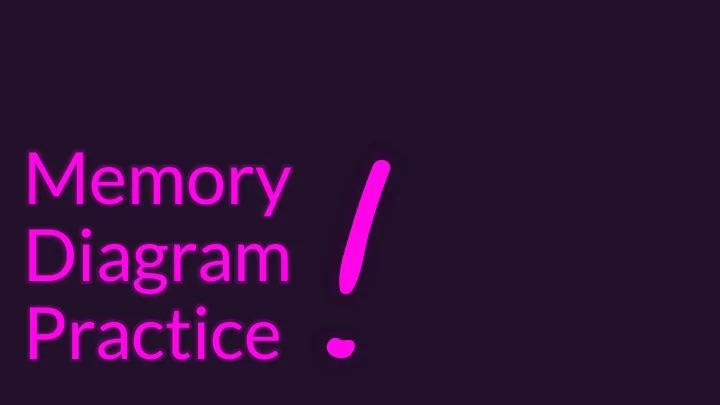

Memory Diagram Practice
Environment Dia iagrams Function Definitions: Enter name in current frame and draw arrow to Function object on 1. Add columns for Call Stack, Heap, and Output heap labeled 2. Add a Globals frame to Call Stack Current Frame: The most recently added frame Function Call that has not returned. (No RV!) 1. Verify and prepare for call i. Is function name bound in your diagram or built-in? ii. Fully evaluate each argument's expression Name Resolution: Look for name in the current iii. Do arguments match function parameters? frame. Not there? Check Globals frame! 2. Establish new frame on call stack i. Add name of function ii. Add RA (Return Address line #) Variable Initialization: Enter name and space for iii. Copy arguments to parameters bound in frame variable in current frame. 3. Jump to first line of function definition Variable Assignment: Find variable's location via Function Return Statement name resolution, copy assigned value to it. 1. Evaluate returned expression • Add RV (Return Value) in current stack frame Variable Access: Find variable via name 2. Jump back to function caller resolution, use value currently assigned to it. i. Line is in RA (Return Address) ii. The function call evaluates to last frame's RV
Diagram 0: Jump Around • Assume the special dunder variable __name__ is assigned "__main__" in the evaluation of this program. • Try drawing diagram yourself for 3 minutes, then discuss in breakout rooms for another 3-5 minutes • Respond on Gradescope to the Diagram 0 questions. 3
4
Diagram 1: CPU go brr • Assume the special dunder variable __name__ is assigned "__main__" in the evaluation of this program. • Try drawing diagram yourself for 3 minutes, then discuss in breakout rooms for another 3-5 minutes • Respond on Gradescope to the Diagram 1 questions.
Function Evaluation - Gradescope What is the result of evaluating the function call expression: cute(3)
Notes on Nested Loops • General Rule: When the closing curly brace of a loop is encountered, the loop jumps back to the start of its matching condition . • An inner loop will jump back up to the inner loop's condition and an outer loop will jump back up to the outer loop's condition. • Thus, an inner loop must complete all of its iterations for every individual iteration of an outer loop.
Recommend
More recommend